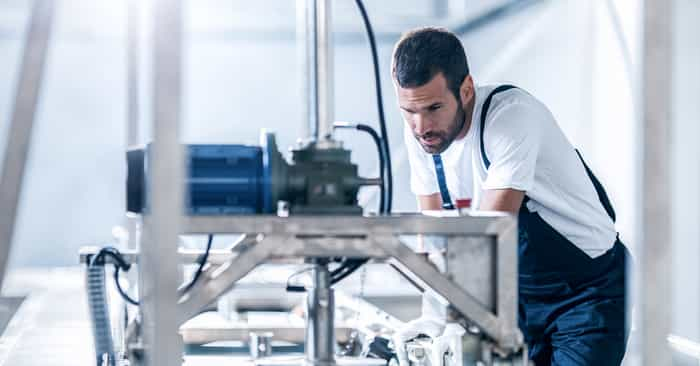Updated April 4, 2025
In the wake of sweeping new U.S. tariffs that have rattled global markets and reignited trade tensions, manufacturers are once again facing hard choices about the resilience—and cost—of their supply chains.
On April 2, 2025, President Donald Trump signed a bold executive order imposing up to 34% in tariffs on Chinese imports, along with significant levies on goods from the EU, Japan, South Korea, and more. The announcement shocked trade partners, triggered market drops across Europe and Asia, and cast serious doubt on the stability of international sourcing.
“The magnitude of the rollout—both in scale and speed—wasn’t just aggressive; it was a full-throttle macro disruption.”
— Stephen Innes, Chief Global Market Strategist, SPI Asset Management
With foreign retaliation expected and inflationary pressure looming, U.S. manufacturers are urgently re-evaluating their global operations. For many, this means accelerating plans to reshore production, bringing it back to American soil to minimize exposure to geopolitical risk, supply chain breakdowns, and rising import costs.
"Nobody is really clear right now... Are the tariffs going to stay for longer? Or are these tariffs just poker chips on the table?"
— Andreas Haag, CEO, Streamliners Management Consulting, for Manufacturing Dive
This uncertainty is forcing companies to rethink their global supply chain dependencies, and many are turning their attention toward reshoring as a more stable long-term solution.

What Is Reshoring?
Reshoring—also referred to as nearshoring—is the process of bringing manufacturing operations back to a company's original country, often from overseas locations. While offshoring became the go-to strategy for reducing costs in the early 2000s, recent global disruptions, rising labor costs abroad, and increasing consumer demand for faster delivery are reversing that trend.
Why Are Companies Reshoring Now?
The COVID-19 pandemic exposed serious vulnerabilities in global supply chains. Shipping delays, raw material shortages, and factory shutdowns left many manufacturers scrambling for alternatives. What once seemed like a cost-efficient system revealed a high risk of disruption and dependency.
The current tariff environment is not only making offshoring riskier—it's also underscoring the need to build smarter, more resilient domestic operations. That's where automated technologies like ASRS come into play.
According to Kearney's 2024 US Reshoring Index, companies are reshoring to:
-
Gain better supply chain control
-
Shorten lead times
-
Increase resilience against disruptions
-
Strengthen national economic security
Why Small and Mid-Sized Manufacturers Are Especially Vulnerable to Tariff Changes
Unlike large multinationals with diverse supplier networks and deep pockets, smaller manufacturers have less pricing flexibility, fewer sourcing options, and lower tolerance for cost volatility.
For these firms, relying on foreign-sourced materials or components becomes a liability—especially as tariff coverage expands into Europe and other traditionally stable trade partners.
Some businesses have attempted workarounds, such as importing unfinished goods and doing final assembly in the U.S. But these solutions are short-term and often costly, especially when labor-intensive processes like welding or machining are involved.
"If the industry can successfully recruit more labor and effectively integrate automation, tariffs in the long run could prove successful at growing domestic manufacturing."
— Andreas Haag, CEO of Streamliners Management Consulting, for Manufacturing Dive
What Are the Benefits of Reshoring?
Reshoring is no longer just a contingency plan—it's a strategic move to improve resilience, reduce long-term costs, and regain operational control in an increasingly complex global market.
While offshoring once promised low labor costs and scale, it also came with hidden risks: volatile international relations, freight delays, and rising tariffs.
In contrast, reshoring offers tangible, sustainable advantages.
Here are just a few of those advantages:
1. Improved Supply Chain Resilience
Reshoring shortens the supply chain both physically and logistically, reducing the number of failure points in transportation and sourcing. It enables companies to adapt more quickly to market shifts while minimizing exposure to geopolitical instability, port delays, and overseas factory shutdowns.
By bringing manufacturing closer to home, businesses gain tighter oversight and greater agility—allowing for faster decision-making and a more resilient response to global disruptions.
2. Reduced Exposure to International Tariffs and Trade Barriers
International trade has become increasingly complex. Shifting geopolitical alliances, new trade agreements, and retaliatory tariffs are making offshore manufacturing more expensive—and riskier.
For example:
-
U.S. tariffs on Chinese goods (as part of ongoing trade disputes) have increased costs for electronics, automotive components, and machinery
-
The complexity of managing origin documentation and customs compliance for each shipment is growing
-
Trade policy can change rapidly, leaving manufacturers exposed to new tariffs with little notice
Reshoring mitigates these risks.
By producing goods domestically, companies avoid foreign tariffs and benefit from more predictable regulatory environments, leading to more consistent margins and long-term stability.
3. Lower Transportation and Logistics Costs
Shipping freight across oceans is not only expensive—it's unpredictable. Ocean freight costs surged during the pandemic and remain volatile due to fuel prices, port congestion, and labor strikes.
By moving production closer to end customers, reshoring can:
-
Significantly reduce shipping expenses
-
Eliminate port and customs delays
-
Improve delivery timelines and reliability
-
Reduce carbon emissions associated with long-haul freight
This is especially important for just-in-time manufacturers who rely on tightly coordinated delivery schedules.
4. Faster Time-to-Market
Reshoring brings production closer to customers, allowing manufacturers to respond to market changes in real time. Localized operations enable faster product customization, quicker prototype iteration, and shorter lead times, making it easier to meet seasonal or regional demand.
This agility is especially valuable in fast-paced industries like consumer electronics, apparel, and automotive, where speed to market can provide a significant competitive edge.
5. Better Quality Control and IP Protection
Reshoring improves visibility and quality control by allowing manufacturers to oversee operations directly. With production closer to home, companies can conduct in-person inspections, enforce stricter quality standards, and identify issues earlier in the process. This leads to fewer defects, reduced rework, and lower warranty and service costs over time.
Reshoring offers stronger protection for intellectual property. Unlike in many low-cost offshore locations where IP laws can be inconsistent or weakly enforced, domestic manufacturing allows companies to safeguard proprietary processes, designs, and data more effectively—minimizing the risk of counterfeiting or IP theft.
Manufacturers of high-tech or proprietary products especially benefit from tighter control over processes, data, and product integrity.

6. Domestic Job Creation and Community Development
Reshoring supports local economies by creating jobs in manufacturing, logistics, and engineering, while also boosting demand for regional suppliers and small businesses. It can drive economic revitalization, particularly in post-industrial areas that have faced decades of decline due to offshoring.
Beyond economic impact, reshoring often enhances brand perception and aligns with ESG (Environmental, Social, and Governance) goals. Companies that invest in domestic production are seen as more ethical, community-focused, and environmentally responsible—qualities that resonate with modern consumers and stakeholders.
"Automation isn't replacing the workforce - it's unlocking its full potential. Technologies like ASRS let manufacturers do more with the same headcount. Or even less. That's because ASRS creates room to grow--physically and operationally."
— Christina Dube, Director of Marketing, Americas at Kardex
7. Easier Compliance with U.S. Regulations
Reshoring simplifies regulatory compliance by eliminating the complexity of navigating foreign labor laws, environmental policies, and safety standards. With domestic production, manufacturers can more easily adhere to OSHA workplace safety regulations, EPA environmental guidelines, and U.S. labor laws.
Additionally, reshoring helps companies meet requirements under the Buy American Act and other government contracting standards, making it easier to qualify for federal and state projects while reducing legal and compliance risks.
ASRS Multiplies the Benefits of Reshoring
Each of the benefits above becomes more accessible and cost-effective when paired with automated storage and retrieval systems.
Rather than building out new facilities or hiring large teams in an already tight labor market, manufacturers are turning to automation—and specifically, Automated Storage and Retrieval Systems (ASRS)—to unlock growth without expanding overhead.

Vertical Lift Modules, Vertical Buffer Modules, Vertical Carousel Modules and Horizontal Carousel Modules are automated storage and retrieval systems which consolidate inventory stored on traditional shelving into a more compact footprint.
With up to 85% floor space savings, manufacturers can make room to expand production locally instead of relying on suppliers abroad.
| Reshoring Benefit | ASRS Advantage |
|---|---|
| Reducing labor costs | ASRS reduces workforce needs by up to 2/3 |
| Saving space | Up to 85% floor space savings allows domestic scaling |
| Handling safety stock | High-density storage enables local JIC inventory |
| Speeding time-to-market | Faster picking and order fulfillment |
| Quality & compliance | Improved traceability and controlled storage environments |
| Transportation cost savings | Consolidated operations reduce internal material handling |
ASRS allows manufacturers to reshore without rebuilding from scratch—maximizing the return on reshoring investments while minimizing the challenges.
To make an informed decision, companies need to assess the total cost of ownership for offshoring versus reshoring.
Offshoring vs Reshoring
As global supply chains become more volatile, manufacturers are re-evaluating whether offshoring still makes sense. While offshoring once promised lower costs, reshoring offers more control, speed, and resilience in today's uncertain climate.
Here's a side-by-side look at the two strategies:
| Factor | Offshoring | Reshoring |
|---|---|---|
| Cost Control | Lower labor costs, but rising tariffs, shipping, and oversight costs | Higher labor costs, but reduced transportation and risk-related expenses |
| Supply Chain Resilience | Vulnerable to global disruptions, delays, and political instability | Localized, stable, and easier to manage in times of crisis |
| Lead Times | Long and variable due to overseas logistics | Shorter and more predictable, allowing faster delivery |
| Product Customization | Slower iteration and response to changing demand | Faster prototyping and customization |
| Quality Control | Limited oversight, higher potential for defects | In-person inspections and consistent quality assurance |
| Intellectual Property | Increased risk of IP theft in some foreign jurisdictions | Stronger IP protections under U.S. laws |
| Regulatory Compliance | Complex international laws and labor standards | Simplified adherence to OSHA, EPA, and U.S. regulations |
| Environmental Impact | High emissions from long-distance shipping | Lower carbon footprint due to proximity and efficiency |
| Public Perception / ESG | May face criticism for poor labor or sustainability practices | Supports local jobs, communities, and ethical sourcing |
| Scalability | Limited by distance and supplier relationships | Enhanced by automation (e.g., ASRS), flexible layouts, and local partnerships |
What are the Disadvantages of Reshoring
While reshoring presents a strong business case in today's climate, it's not without its challenges. For many manufacturers, the decision to bring operations back home comes with a new set of operational hurdles to solve—particularly around cost, space, and labor.
Here are the most common concerns companies face when considering reshoring:
1. Higher Domestic Labor Costs
One of the most cited disadvantages of reshoring is the higher cost of labor in North America compared to offshore locations. Manufacturers moving operations back home often face increased hourly wages, benefits costs, and compliance requirements. While these costs are more stable and predictable than in some foreign markets, they can still put pressure on margins—especially if operations remain labor-intensive.
2. Limited Facility Space
Reshoring often requires scaling production capacity, but most facilities weren't designed to house both expanded manufacturing lines and increased inventory. Constructing new buildings or expanding existing ones can be prohibitively expensive and time-consuming—not to mention the added operating costs of maintaining more square footage.
3. Upfront Capital Investment
Reshoring may reduce long-term costs, but the initial investment can be significant, especially when updating or reconfiguring facilities to meet new capacity demands. Equipment, systems integration, workforce training, and material flow redesigns all require time and capital before ROI can be realized.
4. Labor Availability and Skills Gap
The U.S. is facing a well-documented shortage of skilled labor in manufacturing. Even when companies are ready to reshore, they may struggle to find enough qualified workers to meet production goals. Recruiting, training, and retaining staff is often more difficult—and more expensive—than anticipated.
5. Longer Ramp-Up Times
Reshoring isn't always a quick fix. It can take months—or even years—to fully stand up a new domestic production line. During this transition, companies may face operational slowdowns or parallel costs as they wind down offshore operations and scale up at home.
How to Solve Reshoring Challenges with Warehouse Automation
Reshoring may require ramping up domestic production—but that doesn't mean you need to triple your headcount.
ASRS technologies operate on a "goods-to-person" principle, which delivers inventory directly to an operator at an ergonomic access point. This eliminates time spent walking aisles, searching for parts, or dealing with inventory inaccuracies.
The result?
-
Up to 2/3 reduction in labor needs for picking and inventory tasks
-
Dramatic improvements in order accuracy and speed
-
Safer, more ergonomic working conditions for employees
Here are some of the ways ASRS can address reshoring challenges.
| Reshoring Challenge | ASRS Advantage |
|---|---|
| Higher labor costs | Automates storage and retrieval to reduce manual labor by up to 2/3 |
| Limited space for expansion | Saves up to 85% of floor space, freeing room for additional production capacity |
| Upfront capital investment | Faster ROI through labor savings, space consolidation, and productivity gains |
| Skilled labor shortages | Minimizes reliance on hard-to-fill roles by automating repetitive tasks |
| Longer ramp-up times | ASRS can be installed in existing facilities and scaled incrementally |
| Inventory management complexity | Real-time tracking, reduced errors, and seamless WMS/ERP integration |
How to Get Started with Automation in Your Warehouse
Implementing an Automated Storage and Retrieval System (ASRS) is a strategic move that can transform your warehouse into a high-efficiency, space-saving engine of productivity. Here's how to begin the journey—smartly, sustainably, and with minimal disruption.
1. Evaluate Your Current Warehouse Operation
Before diving into automation, assess your existing layout, inventory flow, and storage capacity. Identify key pain points:
Are workers spending too much time walking and searching? Is inventory spilling into overflow areas or stored offsite? Are frequent stockouts or mispicks slowing down fulfillment?
A clear picture of your current operations will help pinpoint exactly where ASRS can deliver the most value.
2. Set Measurable Goals
Defining your goals up front will drive smarter decisions later. Whether you're aiming to:
-
Reclaim floor space
-
Reduce picking labor
-
Improve inventory accuracy
-
Enable localized safety stock to support reshoring
...be sure to tie your ASRS investment to clear, measurable outcomes. This focus helps prioritize the right solutions and builds a strong case for ROI.
3. Choose the Right ASRS Technology
There's no one-size-fits-all solution—each ASRS type offers different strengths depending on your facility layout, product mix, and throughput needs. For example:
-
Vertical Lift Modules (VLMs) offer tall, modular storage perfect for maximizing vertical space with mixed inventory sizes.
-
Vertical Buffer Modules (VBMs) support rapid picking with robotic delivery trays ideal for small parts and high-turnover SKUs.
-
Carousel Modules (Vertical or Horizontal) provide dense storage for repetitive access to a large number of similar-sized items.
If your facility handles a mix of product types, a hybrid approach may be the most effective.
4. Consider Software and System Integration
Integrating ASRS with your existing systems—WMS, ERP, or MES—is critical for operational success. Seamless integration allows for real-time inventory tracking, automated replenishment, and faster order processing.
Modern ASRS systems typically offer API or middleware support to sync with enterprise platforms. It's worth involving your IT and ops teams early to ensure compatibility and scalability.
5. Plan the Installation Strategically
ASRS doesn't require gutting your warehouse. Most systems are modular and designed for installation within existing spaces, allowing phased rollouts that minimize disruption.
Start small. A focused pilot in a high-traffic or high-value inventory zone allows you to test performance, train staff, and measure early wins before scaling.
6. Train for Adoption, Not Just Operation
Automation is only as effective as the team behind it. Operators should receive hands-on training that focuses on:
-
Safe system use and emergency procedures
-
Efficient picking and replenishment processes
-
Troubleshooting and basic maintenance
-
Understanding system alerts and data dashboards
The goal isn't just usability—it's confidence and ownership of the new tools.
7. Monitor Performance and Optimize
Once your ASRS is live, tracking key performance indicators is essential. Focus on:
-
Picking accuracy
-
Labor hours saved
-
Inventory turnover improvements
-
Space reclaimed
-
Downtime or errors avoided
Use this data to fine-tune workflows, identify additional automation opportunities, and continuously improve system ROI.
Final Thought - Start Smart, Scale Confidently
ASRS is more than a storage upgrade—it's a gateway to smarter, more resilient operations that support reshoring and long-term growth. Start with clear goals, the right system design, and a phased approach—and you'll unlock savings in labor, space, and time.
ASRS transforms reshoring from a logistical challenge into a strategic opportunity—enabling companies to operate leaner, faster, and smarter on U.S. soil.
If you’re ready to modernize, our experts can help you build a step-by-step plan tailored to your warehouse’s needs. Contact us today to get started.
Looking for actionable organization tips for your reshored warehouse? Check out our free guide: 18 Warehouse Organization Ideas.





